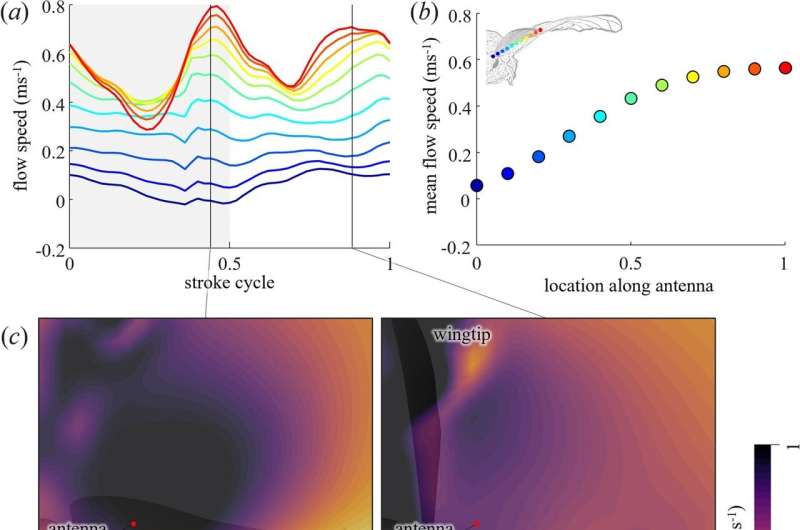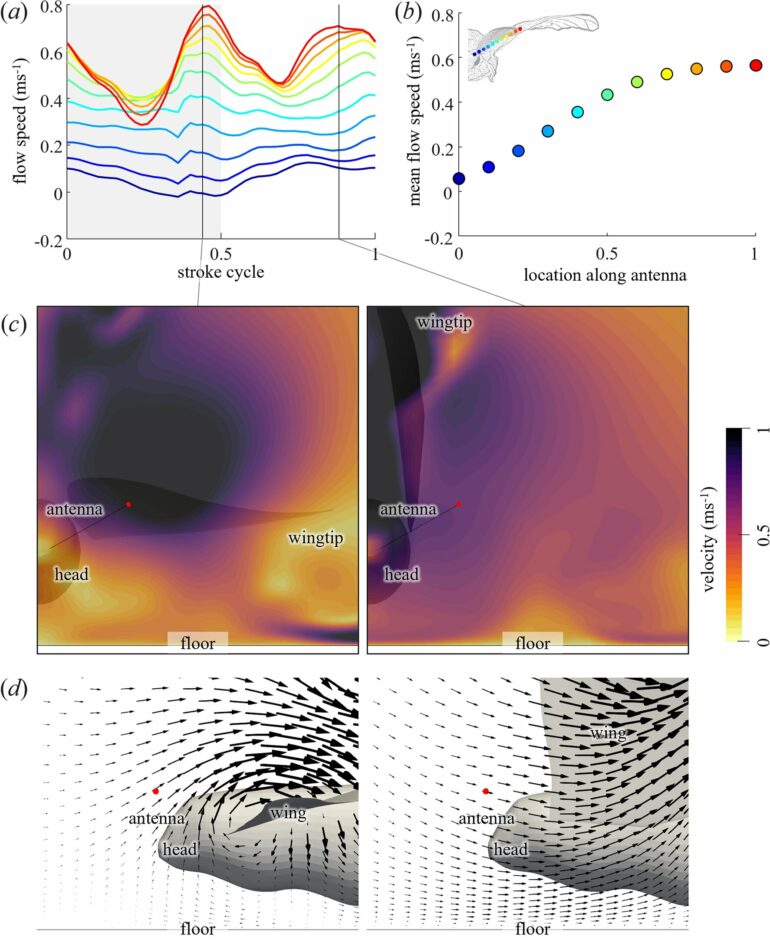The silkworm moth (Bombyx mori) is an insect that no longer flies due to domestication. The males use their antennae to detect pheromones emitted by females and respond very acutely, and have been used as model insects for the study of their odor source localization.
Flying insects flap their wings when they fly, and silkworm moths are also known to flap their wings (called fanning) when they detect pheromones, even though they do not fly. As pheromone molecules move through space in the air, the air flows produced by the flapping of wings undoubtedly have a strong influence on odor detection. However, the effect of this flapping of wings was not known quantitatively.
To address this question, a group of scientists led by Dr. Toshiyuki Nakata from the Graduate School of Engineering, Chiba University, investigated how B. mori detects pheromones. “We understand that silkworm moths detect pheromones by flapping their wings to induce airflows around them. However, the precise impact of this wing flapping on the moths’ ability to localize the odor source is unclear,” explains Nakata, while elaborating on the rationale for conducting this study.
Their study, published on August 2, 2024, in Scientific Reports, employed high-speed photogrammetry—a technique that uses high-speed cameras to capture and reconstruct the motion and geometry of objects—to computationally analyze the aerodynamic consequences of wing motions of B. mori. Researchers meticulously recorded the wing movements during fanning and built a detailed computational model of the insects and surrounding airflow. Using the simulated data, they subsequently calculated the motion of particles that resemble the pheromone molecules around the fanning silkworm moth.
One of the key findings of the study was that B. mori samples the pheromone selectively from the front. The moth scans the space by rotating its body while fanning to locate the pheromone sources. The directional sampling of the pheromone molecules is particularly helpful when searching for an odor source since the moth can determine the direction of the odor plume upon the detection of the pheromone.
Needless to say, the implications of this research extend beyond the study of insects. The insights gained from how B. mori manipulates airflow could lead to advancements in robotic odor source localization technologies. A team led by Dr. Daigo Terutsuki is working on developing drones equipped with insect antennae for odor detection, with potential applications such as locating individuals in emergencies.
“The findings from this study highlight the importance of creating directional airflow when searching for odor sources using flying robots. This involves carefully adjusting the drone’s orientation and the configuration of its propellers and odor sensors to optimize detection capabilities,” notes Dr. Nakata.
Furthermore, the study highlights the need for future research to consider environmental factors such as airflow turbulence and antenna structure, which also influence odor detection.

Induced flow around the antenna by the fanning of a silkworm moth. (a) Time series and (b) cycle average of the induced flow speed at the antenna. The colors represent the location along the antenna, as shown in the insets in (b). (c) Snapshots of the velocity on the frontal plane at the tip of the antenna (red dot) when the flow velocity is maximized. (d) Side view of the vector field on the vertical plane at the tip of the antenna (red circle). © Scientific Reports (2024). DOI: 10.1038/s41598-024-67966-y
“Currently, robots rely heavily on vision and auditory sensors for navigation. However, as demonstrated by disaster rescue dogs, utilizing the sense of smell can be highly effective for locating humans. While the application of sensing smell in robots is still in its early stages, this research could help in developing robots that efficiently search for odor sources in disaster situations,” says Dr. Nakata.
In summary, this study not only advances our knowledge of insects’ odor-detecting strategies but also provides valuable design principles for the next generation of aerial odor-detecting robots.
The team included co-first author, Daigo Terutsuki from the Faculty of Textile Science and Technology, Shinshu University; Chihiro Fukui, from the Graduate School of Science & Engineering, Chiba University; Ryohei Kanzaki, from the Research Center for Advanced Science and Technology, The University of Tokyo; and Hao Liu, from the Graduate School of Engineering, Chiba University.
More information:
Olfactory sampling volume for pheromone capture by wing fanning of silkworm moth: a simulation-based study, Scientific Reports (2024). DOI: 10.1038/s41598-024-67966-y
Citation:
Study uncovers how silkworm moth’s odor detection may improve robotics (2024, October 15)



